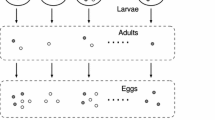Abstract
Exact definitions in physical and biological terms of the coefficients in Volterra's (1926, 1931) original competition equations are indispensable for the understanding of the system. In agreement with Volterra's own, but not quite sufficient specifications, it is tried in this paper to give more precise definitions of the parameters used by Volterra. This leads to some consequences; i.a. that there does not exist a “principle of competitive exclusion”. In order to allow for competitive exclusion — or for stabilization — the Volterra equations need additional biophysical specifications and mathematical modifications. Some such modifications are proposed, for instance for aggressive interference as a function of population numbers.
Similar content being viewed by others
References
Ayala, F.J. (1969). Experimental invalidation of the principle of competitive exclusion. - Nature 224, 1076–1079.
Begon, M. and A. Mortimer (1981). Population ecology. - Oxford and London: Blackwell Scientific Publications, 200 p.
Gause, G.F. (1934). The struggle for existence. - New York: Hafner. Reprinted 1964.
Gause, G.F. and A.A. Witt (1935). Behaviour of mixed populations and the problem of natural selection. - The American Naturalist 69, 596–609.
Hutchinson, G.E. (1979). An introduction to population ecology. - New Haven and London: Yale University Press, 260 p.
May, R.M. (1976). Models for two interacting populations. - In: R.M. May (ed.), Theoretical ecology, pp. 49–70. - Oxford and London: Blackwell Scientific Publications. 317 p.
McArthur, R.M. (1972). Geographical ecology. - New York: Harper and Row, 269 p.
Pianka, E.R. (1976). Competition and niche theory. - In: R.M. May (ed.), Theoretical ecology, pp. 114–141. - Oxford and London: Blackwell Scientific Publications. 317 p.
Slobodkin, L.B. (1961). Growth and regulation of animal populations. - New York: Hart, Rinehart and Winston, 189 p.
Vandermeer, J. (1981). Elementary mathematical ecology. - New York and Toronto: Wiley, 294 p.
Volterra, V. (1926). Variazoni e fluttuazioni del numero d'individui in specie animali conviventi. - Atti R. Acad. Naz. del Lincei 1, 1–85.
Volterra, V. (1931). Ricerche matematiche sulle associazioni biologiche. - Estratto dal Giornale dell' Istituto Italiano degli Attuari 2/9, 65 p.
Walker, I. (1967). Effect of population density on the viability and fecundity inNasonia vitripennis Walker (Hymenoptera, Pteromalidae). - Ecology 48, 294–301.
Walker, I. (1975). Density-dependent control of fission rates in the marine ciliateKeronopsis rubra Ehrenberg (Hypotricha, Oxytrichidae). - The J. anim. Ecol. 44, 707–717.
Walker, I. (1979). Mechanisms of density-dependent population regulation in a marine copepod (Amphiascoides spec, Harpacticoida) from the Dar-es-Salaam coast. Mar. Ecol. Progr. Ser. 1, 209–221.
Walker, I. (1979). Rede de alimentação de invertebrados das águas pretas do sistema Rio Negro. 1. Observações sobre a predação de uma ameba do tipoAmoeba discoides. - Acta Amazonica 8, 423–438.
Wilson, E.O. and W.H. Bossert (1971). A primer of population biology. - Sunderland, Mass.: Sinauer Associates.
Author information
Authors and Affiliations
Rights and permissions
About this article
Cite this article
Walker, I. The physical dimensions and biological meaning of the coefficients in the Volterra competition equations and their consequences for the possibility of coexistence. Acta Biotheor 32, 93–122 (1983). https://doi.org/10.1007/BF02045063
Received:
Revised:
Issue Date:
DOI: https://doi.org/10.1007/BF02045063




